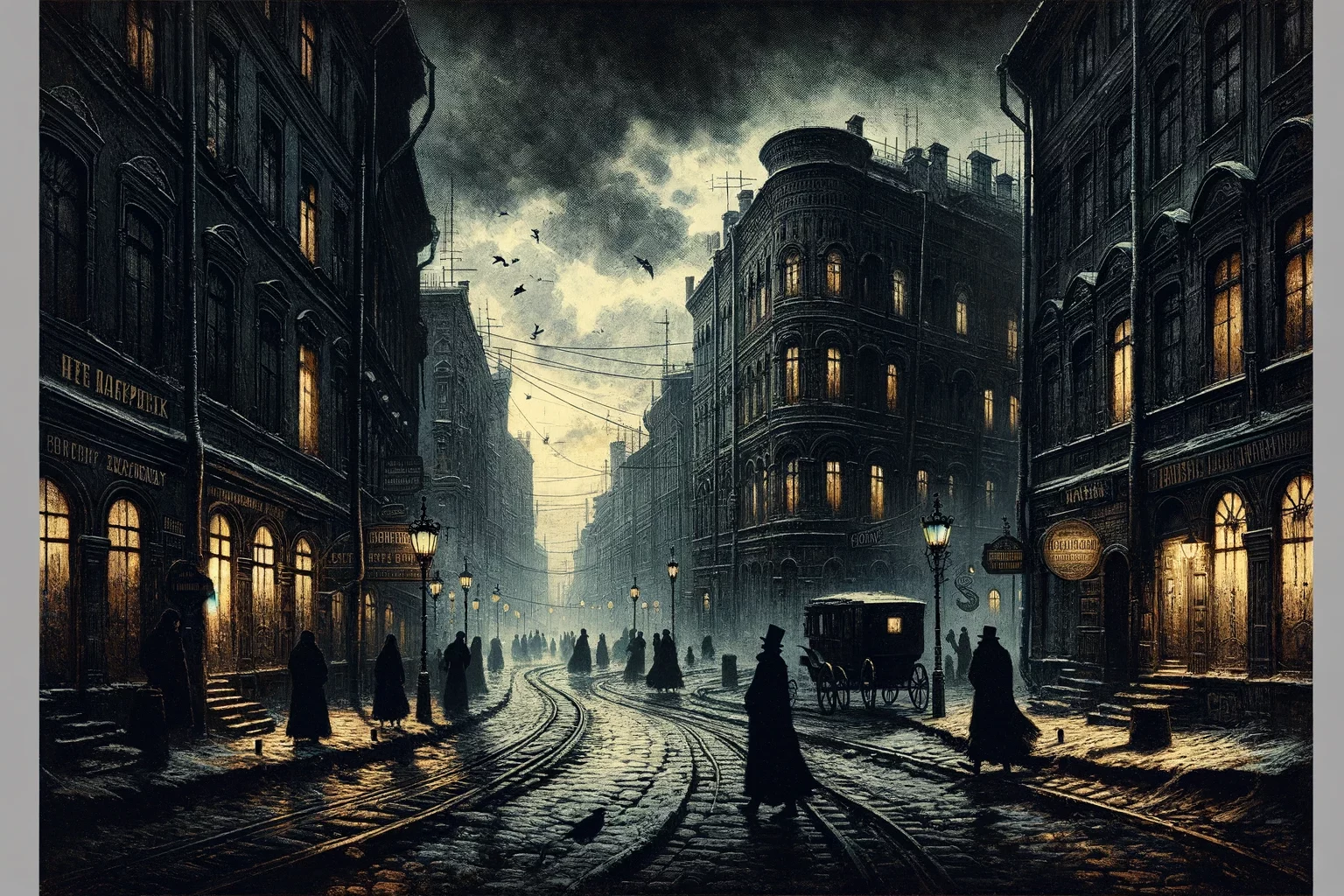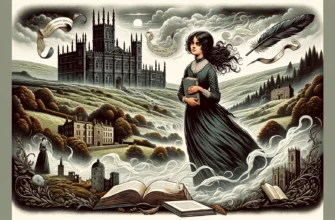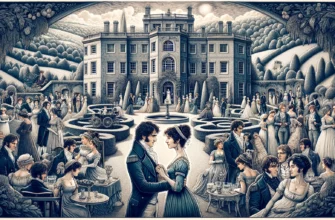Crime and Punishment: The Genesis of Despair in Raskolnikov’s Plight
Fyodor Dostoevsky introduces the protagonist, Rodion Raskolnikov, in the tumultuous environment of St. Petersburg in the 1860s. The city’s stark contrasts between wealth and poverty backdrop Raskolnikov’s impoverished life.
A former student, Raskolnikov is portrayed as an intelligent yet needy young man grappling with financial hardship and a growing detachment from society. Dostoevsky meticulously portrays the stifling atmosphere of the cramped, oppressive city, reflecting Raskolnikov’s internal turmoil.
Raskolnikov’s intellectual prowess led him to formulate the theory of the ‘extraordinary man,’ a concept that allows him to justify actions beyond the moral constraints that govern ordinary individuals. This theory becomes a central pillar of his psyche, pushing him towards the moral precipice.
His dire financial situation exacerbates his inner turmoil, his inability to support his family, and his perception of the pawnbroker, Alyona Ivanovna, as a parasitic entity. These factors culminate in his decision to commit murder, setting the stage for the novel’s exploration of moral, philosophical, and psychological themes.
Exploring “Crime and Punishment” by Fyodor Dostoevsky offers a profound journey through one of the best classic books, unveiling the depths of the human psyche and morality.

Dostoevsky masterfully sets the stage for a narrative that delves deep into the human psyche. The author’s insight into Raskolnikov’s internal conflict, coupled with his vivid depiction of the social conditions of the time, creates a rich tapestry that illustrates the protagonist’s descent into despair.
The chapter underscores the complex interplay between individual psychology, societal pressures, and moral philosophy, setting the groundwork for the unfolding drama.
The Crime: A Dual Murder
The act of murder serves as the fulcrum of “Crime and Punishment,” marking the moment when Raskolnikov’s theoretical musings collide with brutal reality. Dostoevsky meticulously details the planning and execution of the murder of the pawnbroker Alyona Ivanovna and her sister Lizaveta.
The narrative captures the tension and horror of the act, as well as the chaotic and unplanned murder of Lizaveta, who unexpectedly witnesses the crime. The graphic depiction of the murder scene underscores the violence of Raskolnikov’s actions and the stark departure from his intellectual justifications.
The aftermath of the crime plunges Raskolnikov into a psychological abyss. His behavior becomes increasingly erratic, marked by bouts of paranoia, guilt, and delirium.
Dostoevsky employs a psychological realism that allows readers to delve into the protagonist’s disturbed mind, experiencing his confusion and turmoil firsthand. The narrative technique of shifting perspectives enables a multifaceted view of the events, enhancing the suspense and moral tension that permeate the novel.
Dostoevsky’s exploration of the moral implications of the crime is profound. The author does not merely present a murder; he delves into the psyche of a man who tries to rationalize his actions under a self-conceived philosophical framework.
The contrast between Raskolnikov’s intellectual rationalizations and the gruesome reality of his actions invites readers to reflect on the nature of crime, guilt, and morality. This chapter sets the stage for the protagonist’s subsequent journey through guilt, punishment, and redemption.
The Labyrinth of Guilt: Raskolnikov’s Mental Turmoil
Following the crime, Raskolnikov enters a labyrinth of guilt and psychological turmoil. Dostoevsky portrays his protagonist’s post-crime mental state with intense realism, capturing the fluctuations of his consciousness, from feverish delusions to moments of lucid guilt and self-loathing.
Raskolnikov’s mental and emotional instability is depicted with such depth that readers are drawn into his inner world, experiencing his anguish and disorientation.
The interactions between Raskolnikov and the other characters in the novel mirror his psychological state. His relationships with his mother, Pulcheria Alexandrovna, his sister, Avdotya Romanovna (Dunya), and his friend, Razumikhin, are strained and erratic, reflecting his inner conflict.
These characters and the astute detective Porfiry Petrovich play crucial roles in the narrative, acting as catalysts for Raskolnikov’s eventual confrontation with his conscience. Dostoevsky uses dialogue and the subtle interplay of character dynamics to deepen the psychological realism of the novel.
This chapter also examines alienation, a recurrent motif in Dostoevsky’s works. Raskolnikov’s isolation, both self-imposed and societal, is a critical factor in his psychological deterioration.
The vivid portrayal of his mental anguish and the societal backdrop against which it unfolds provide a compelling exploration of the human condition. Dostoevsky’s insight into the depths of Raskolnikov’s despair offers a profound commentary on the consequences of alienation and the complexity of the human psyche.
The Cast of St. Petersburg: A Gallery of Characters
“Crime and Punishment” is renowned for its central character and rich cast of secondary characters, each adding depth and complexity to the narrative.
This chapter introduces characters such as the tragic figure of Marmeladov, an impoverished civil servant, his daughter Sonia, driven to prostitution out of desperation, and Svidrigaïlov, a man with a mysterious past and dubious intentions. These characters are not mere backdrops but integral to the narrative, reflecting different facets of Russian society and human nature.
The interactions between Raskolnikov and these characters are pivotal to the plot’s development and the protagonist’s inner journey. Sonia, in particular, becomes a significant figure in Raskolnikov’s life, representing themes of suffering, sacrifice, and redemption.
Her relationship with Raskolnikov is complex and multifaceted, symbolizing the possibility of salvation and spiritual rebirth. Dostoevsky skillfully weaves these characters’ stories into the main narrative, enriching the novel’s moral and existential dilemmas exploration.
The portrayal of St. Petersburg society through these characters provides a window into the time’s social, economic, and moral complexities. Dostoevsky’s acute observation of human nature and societal dynamics is evident in his nuanced depiction of each character.
The interplay of these characters with Raskolnikov adds layers to the narrative, making “Crime and Punishment” not just a story of one man’s moral conflict but a broader commentary on the human condition. This chapter highlights the author’s mastery in creating a vivid, dynamic world populated with characters who resonate with readers long after the story ends.
The Pursuit of Justice: Porfiry Petrovich’s Investigation
Porfiry Petrovich, the astute and methodical detective, is a central figure in pursuing justice in “Crime and Punishment.” Dostoevsky crafts Porfiry as a foil to Raskolnikov, showcasing a battle of wits that delves into psychology and philosophy.
The detective’s approach to the investigation is not through brute force or traditional detective work but through a nuanced understanding of human psychology. Porfiry’s tactic of sowing seeds of doubt and employing psychological pressure is a testament to Dostoevsky’s deep knowledge of the human psyche.
The interactions between Porfiry and Raskolnikov are charged with intellectual and moral tension. Porfiry’s indirect approach, seemingly casual conversations laden with hidden meanings, and allowing the suspect to reveal himself through his words and actions create a captivating cat-and-mouse game.
Dostoevsky masterfully uses these encounters to build suspense and deepen the narrative’s psychological complexity. The reader is drawn into the mental duel, witnessing the gradual unraveling of Raskolnikov’s facade.
This chapter also delves into the broader legal and ethical themes presented in the novel. Dostoevsky uses Porfiry’s character and his interaction with Raskolnikov to explore the nature of justice, the role of law in society, and the moral responsibility of individuals.
Porfiry’s pursuit of justice is not just a quest to solve a crime but also a deeper probe into the moral fabric of humanity. The chapter highlights Dostoevsky’s critique of the justice system and explores the tension between legal justice and moral righteousness.
Redemption and Suffering: Sonia and the Path to Atonement
In Raskolnikov’s tumultuous life, Sonia Marmeladova emerges as a beacon of hope and redemption. Her character starkly contrasts the bleak and oppressive environment of St. Petersburg and Raskolnikov’s tormented mind.
Dostoevsky portrays Sonia as a figure of suffering and sacrifice whose moral and spiritual purity shines amidst the darkness of the narrative. Her relationship with Raskolnikov is complex and deeply symbolic, representing a path to redemption and spiritual awakening.
Sonia’s influence on Raskolnikov is profound. Through her suffering and unwavering faith, she offers a glimpse of salvation and the possibility of redemption through suffering. Her acceptance of her plight and compassion for Raskolnikov’s tormented soul starkly contrast his nihilistic worldview.
Dostoevsky uses their relationship to explore themes of faith, morality, and the redemptive power of love and compassion. Sonia’s character is a testament to the endurance of the human spirit and the possibility of redemption through suffering and sacrifice.
The chapter delves into the religious and existential themes central to the novel. Sonia’s character embodies the Christian ideals of forgiveness, sacrifice, and redemption. Her interactions with Raskolnikov and her influence on his journey toward confession and atonement highlight the novel’s exploration of spiritual rebirth.
Dostoevsky’s portrayal of Sonia as a symbol of hope and redemption amidst the despair and moral ambiguity of the narrative offers a profound commentary on the human capacity for suffering, compassion, and redemption.
The Conclusion: Rebirth in Siberia
The final chapters of “Crime and Punishment” poignantly conclude Raskolnikov’s tumultuous journey. His confession, trial, and subsequent exile to Siberia mark the culmination of his inner turmoil and moral struggle.
Dostoevsky presents Raskolnikov’s punishment as a legal consequence of his crime and a crucial step toward his psychological and moral rebirth. The harshness of Siberian exile is a backdrop for Raskolnikov’s gradual transformation and redemption.
The relationship between Raskolnikov and Sonia deepens in Siberia, with Sonia following him into exile. Her unwavering support and love become the catalysts for Raskolnikov’s transformation.
Dostoevsky uses their relationship to illustrate the power of compassion and human connection in the face of suffering. The stark landscape of Siberia, with its harsh conditions and the isolation it imposes, becomes a symbol of Raskolnikov’s internal desolation and his quest for redemption.
This chapter concludes the narrative and reflects on the novel’s broader themes. Raskolnikov’s journey from a man tormented by his intellectual theories and moral dilemmas to one who finds redemption through suffering and love is a powerful testament to Dostoevsky’s exploration of the human condition.
The novel’s enduring themes of guilt, redemption, and the search for meaning resonate beyond the confines of the narrative, cementing “Crime and Punishment” as a masterpiece of psychological and philosophical literature.







